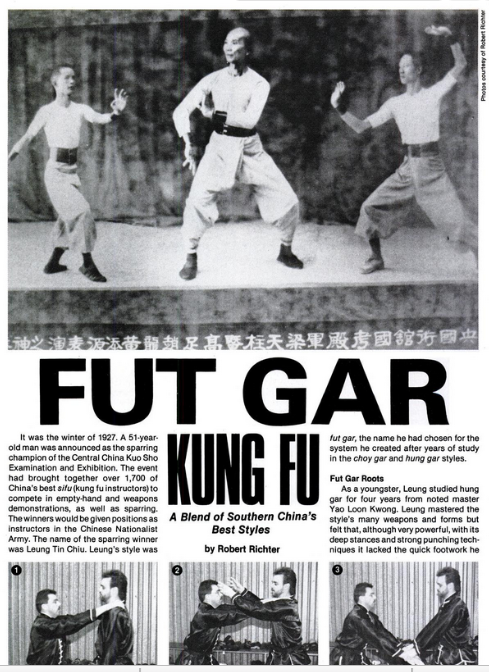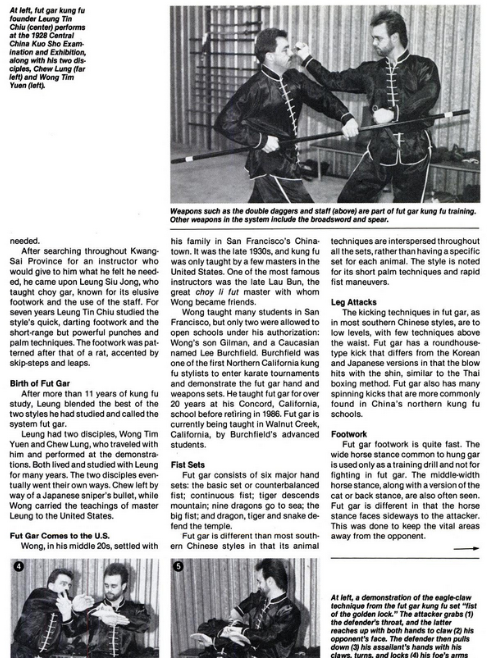
Old Fut Gar Article





Kung Fu Styles and Forms
Fut Gar is a Northern Shaolin style of Kung Fu which utilizes mostly punches, palm strikes and low kicks. It is further characterized by evasive footwork, circular blocks and using the opponent’s force against him/her.
The words “Fut Gar” literally translate to “Buddha Family”. The word “Kuen” in Cantonese would translate to “fist”. “Fut Gar Kuen” would be “Buddha Family’s Fist”
Fut Gar Training
Fut Gar training includes self-defence, hei (qi) gung, weapons, traditional forms, exercises for health, philosophy and meditation, inner strength, discipline, and confidence. Offensive techniques in Fut Gar are diverse and include wide, circular hook punches and hammer fists. Evasive footwork and circular blocks are some of the defensive techniques used. Benefits of Fut Gar training include: strong fighting theory; short- to medium-range attacks; maneuverability and footwork; heavy focus on hand techniques; flexibility of techniques for all body types.
The Fut Gar style traditionally had three empty-hand sets and nine weapons. The empty hand sets are: Hu Dip Jeong (The Butterfly Palm); Sup Ji Kuen (Cross Fist); and Dai Ga Lu (Great Family Set). There are now ten empty-hand forms to practice starting with a hard, almost Karate-like form, all the way to an internal form similar to Tai Chi Chuan; they are: Seah Ying Diu Sau (Snake Form); Tai Ji Kuen (Prince’s Form); Bak Mok (White Hair); Lohan Kuen (Monk’s Fist); Dai Lin Wan (Large Connection); Dai Gum Gong (Big Solid Body); Chut Yup Bo (Out In Step); Maang Fu Ha San (Fierce Tiger Descending the Mountain); and Tien Jaang (Complete Elbow).
There is also various weapon training The nine original weapons are: the staff, spear, straight sword, broadsword, butterfly swords, kwan do, tiger fork, three-sectional staff, and the monk’s spade.
Some of Fut Gar’s weapons forms include: Hak Loong Dao (Black Dragon Broadsword); Fook Fu Gwun (Tiger Taming Staff); Ng Ma Quite Show (Five Horses Returning to the Feeding Post Staff); and Loong Chien Gim (Dragon Well Sword).

Our Philosophy
What Is The Focus Of Our Teaching?
The belief of Sifu Richard Chow is that Kung Fu is designed for the purpose of training your body to react instinctively to situations as they arise. Generally in Martial Arts training, you will learn hand forms, weapons forms and fighting. Some styles focus heavily on fighting while others focus on hand forms. Our belief is that all techniques and reactions are built by repetitive training in forms and enhanced by practicing fighting in controlled sparring situations. Sifu Chow’s main focus in training is on practicing techniques correctly. Until your body is trained correctly to step, strike, block and kick by practicing your forms, free sparring is of very little value to your development. Once students are proficient at a series of forms, they will be introduced to sparring.
How Are The Classes Run?
We run 2 hour classes that are divided into one hour halves.
The first half of the class is for development of the core competencies needed to properly learn our styles of Kung Fu. This includes footwork/stances, strength training, cardiovascular development, stretching, basic techniques, body conditioning and sensitivity training.
The second half of the class is normally focused on forms training. This part of the class is designed to allow students to improve their forms while receiving individual instruction from the instructors and senior students. We try to get around to each student during the second half of class and introduce some corrections to make for next class.
What Can You Expect?
Our classes are designed to be fun and enjoyable but everybody is expected to try hard. Sifu Chow’s teaching philosophy has always been to try to make training a fun experience. He does not believe in the military style of attitude that is used in some classes today. We treat everyone as an adult and expect each student to build the self-discipline to push themselves to try their hardest at all times.
We do appreciate that each person is different and try to develop each person’s individual strengths while improving on their weak areas.
Is This The Martial Arts Class For Me?
We cannot properly answer this question for you. For our group of students, this is the Martial Arts Class that is best for them. We do recommend that you come try a class and possibly discuss your goals with one of the instructors when you are in the class.
There are several areas that we can definitely address at this time.
If you are only interested in learning how to fight quickly, we are not the Martial Art for you. All Martial Arts are designed to train people how to defend themselves but Kung Fu is quite complex and it takes some time before you are able to easily utilize the techniques in fighting situations.
If you are seeking a children’s class, we unfortunately are not able to help you at this time. Our classes are currently only open to adults.
If you are looking for a Martial Art that will allow you to perform acrobatic techniques, we are not the class for you. We do not teach a style that frequently involves flipping, jumping and spinning. Although you will need to occasionally perform these techniques, they are not a major part of the styles.
If you are seeking a kicking style, we are not the class for you. Our belief is that kicking is an important part of all Martial Arts but the styles we teach are Southern Kung Fu styles that focus less on kicking and more on hand techniques.
If you are looking for a full time school that you can attend every day, we are not the class for you. We run 3 classes per week (2 open classes and 1 advanced class).
If you are looking for an internal style of Martial Arts (such as Tai Chi), we are not the class for you because the styles we teach are external styles of Kung Fu.
If you come and try a class and we are not exactly right for you, we are happy to try and recommend other schools to you. Our instructors know quite a few other instructors in the GTA and would be happy to make a recommendation.

Owner and Head Instructor, Sifu Richard Chow, holds a fifth degree black sash. He is supported by experienced instructors. Our instructors come with many years of teaching experience, Black Sash degrees and an unparrelleled passion for Fut Gar Kung Fu.
Following is a current list of our school’s head instructors. More detailed profiles of each instructor are also provided here.
Sifu Richard Chow
As the Head Instructor of our organization, Richard is responsible for all decisions on the curriculum and martial arts content of the classes.
Sifu Bruce Kinney
Instructor and “defender” of the school. Bruce is Sifu Richard Chow’s first and most senior student.
Sifu David Salvador
Instructor and historian of the organization, David seems to have a story about every member of the school.

Every single student in a class progresses and improves. I guarantee that as long as you go to classes and put in some effort, you will improve. The more important thing is how to maximize your training. Each person learns at a different pace so here are some tips to help do your best.
- Learn something every class – This does not mean that you need to learn a new technique or a new part of your form every class. What I mean is that you need to listen to corrections from your instructor, discover a more effective way to execute a technique that you know, remember that move that you always get stuck on, etc.
- Retain what you learn – Once you learn something in class, you need to ensure that you remember that for next class. To progress you need to be able to retain your past learning and execute on them so you can focus on learning more instead of relearning something.
- Find your capacity – How much can you learn and retain? This is different in every person. Some people can learn and retain one thing each class while others might be able to learn and retain more things. Kung Fu is not a contest so don’t worry about someone else’s pace.
- Repeat – Repetition is the thing that will give your body the muscle memory to execute a technique or form. Ensure that you are spending your time repeating what you learn.
- Question yourself – Ask yourself if you are actually doing this correctly as you practice. Ask yourself if you understand why you are doing something. Ask yourself what you can work on to make your techniques better.
- Listen – So many lessons are taught in our classes. Instructors are teaching students, senior students are teaching junior students, fellow students are discussing techniques with each other, etc. Listen to what is being taught and hopefully you will catch a few pieces of information that you may not have known before.
- Show up physically – During my career as an instructor I have been fortunate enough to be in situations where I could almost always be available for classes. The harder part is being in the habit of going to class on days when you are tired or would prefer to be doing something else.
- Show up mentally – Once you have arrived in class it is now time to prepare to focus. Get yourself prepared to pay attention to the instructors and focus on the techniques you are working on.
- Be proud of yourself – You work hard and continue to improve. Martial arts training is a journey that can last a lifetime so be sure that you remind yourself that you have continued when hundreds, thousands or millions of others did not continue after starting.

Blocking techniques are obviously very important to protect you during a fight. With a bit of work and the proper understanding of the techniques, everybody can become proficient at defending themselves. The next step is to use the blocks the way they are intended which normally means there is more than just stopping an attack.
In a past post I spoke about blocking softly. This is exactly what should be done when redirecting a strike or trying to control with a grab but there are times where you are trying to do something else with the strike. There are times when the technique is intended to be hard because you are trying to damage the striking arm or leg. Look at the blocks you are executing and determine if it is something that is intended to deflect or something that is meant to be more aggressive. With practice and/or the help of your instructors you will see when you can use blocks for the various purposes. Take some time to make some mental notes the next time you are working on your techniques and you will notice a difference in your fighting. Deflections will become harder to detect and hard blocks will become more of a distraction to your opponents.
Better understanding the blocks will also help you focus on the correct angles to execute your block.
When observing students working on their fighting, I often see students intimidated by level or seniority of the other student that they are going to fight with. I was also there at one point but quickly learned that there is no reason to worry and eventually preferred to work with people who were more senior and usually better than I was for some good reasons:
- Nobody actually wants to hurt you in class because we are all there to learn and get better
- More senior students typically have better control of their techniques and are actually less likely to accidentally hurt you
- Fighting with someone better than you forces you to elevate your fighting to match with your opponent’s skill level
- Senior students will often be able to see things in your fighting and be able to give you some pointers on improving your fighting
- With mutual respect and control there is also an opportunity to learn because neither fighter is afraid to get hurt, therefore allowing you to try new techniques
- We are all friends in class